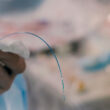At present, the use of drug coated balloons (DCB) in femoropopliteal territory is more and more frequent. However, when it comes to treating moderate to severe calcification, the evidence is still limited. Using a peripheral artery calcification scoring system (PACSS) has been associated to clinical outcomes after DCB angioplasty for femoropopliteal lesions. The system categorizes<a href="https://solaci.org/en/2023/05/11/drug-coated-balloons-link-between-femoropopliteal-lesion-calcification-grade-and-clinical-outcomes/" title="Read more" >...</a>
PICCOLETO-II: Drug-Coated Balloons in Small Vessels
Use of drug-coated balloons vs. drug-eluting stents in small caliber vessels. The constant advancements in coronary device technology have significantly reduced complication rates (such as that of restenosis). However, there are gaps where a high number of undesirable events prevail, such as small vessel disease (SVD), for which, in previous studies up, the rate of<a href="https://solaci.org/en/2023/04/28/piccoleto-ii-drug-coated-balloons-in-small-vessels/" title="Read more" >...</a>
Drug-Eluting Balloon in STEACS: Leaving No Trace is Beneficial?
Using drug-eluting balloons in patients with ST-segment elevation acute coronary syndrome. The benefits of early reperfusion in ST-segment elevation acute coronary syndromes (STEACS) have not been discussed; compared with fibrinolysis, primary percutaneous coronary intervention (pPCI) has shown benefits in terms of mortality. Despite the constant advancements in stent technology and design, these devices are not<a href="https://solaci.org/en/2023/04/18/drug-eluting-balloon-in-steacs-leaving-no-trace-is-beneficial/" title="Read more" >...</a>
Clinical Impact of Coronary Artery Disease on Results After TAVR
Coronary artery disease (CAD) coexists with aortic stenosis in about half the patients who suffer the latter. These patients receiving antiplatelet therapy are at a higher risk of periprocedural bleeding—one of the most frequent complications in patients who undergo transcatheter aortic valve replacement (TAVR). One way of limiting the risk for bleeding is choosing the<a href="https://solaci.org/en/2023/04/17/clinical-impact-of-coronary-artery-disease-on-results-after-tavr/" title="Read more" >...</a>
The most read scientific articles in interventional cardiology in March on our website
Below, we share March’s most read scientific abstracts in interventional cardiology at solaci.org. ACC 2023 | YELLOW III Study. Effect of Evolocumab on Coronary Plaque Characteristics in Stable Coronary Artery Disease Dr. Kini presented the results of the YELLOW III Study where she analyzed the effect of evolocumab on coronary plaque in patients with stable<a href="https://solaci.org/en/2023/04/13/the-most-read-scientific-articles-in-interventional-cardiology-in-march-on-our-website/" title="Read more" >...</a>
Percutaneous Access Closure in TAVR: Are Devices Similar?
One of the challenges that transcatheter aortic valve replacement (TAVR) continues to face is percutaneous access closure with percutaneous closure systems (PCS). However, several systems have been developed, either by plug—such as the MANTA system—or by suture (SU)—such as the ProStar and ProGlide systems. Both of these have been tested in different analyses, but to<a href="https://solaci.org/en/2023/04/12/percutaneous-access-closure-in-tavr-are-devices-similar/" title="Read more" >...</a>
ISAR Score: Can We Predict the Need for Repeat PCI in DES Restenosis?
Score to predict the risk of repeat PCI in DES restenosis. With the use of drug eluting stents (DES) instent restenosis (ISR) has seen a significant reduction vs. bare metal stents (BMS) restenosis. The main cause of DES failure is ISR. This entity is difficult to manage because of its high recurrence and reintervention risk.<a href="https://solaci.org/en/2023/04/12/isar-score-can-we-predict-the-need-for-repeat-pci-in-des-restenosis/" title="Read more" >...</a>
ACC 2023 | Subanalysis of the REVIVED-BICS Study2
This study demonstrated that coronary angioplasty does not entail any benefit in chronic stable angina over optimal medical therapy in those with impaired ventricular function (EF >35%) with extensive coronary artery disease and viable myocardium. Dr. Divaka Perera performed a subanalysis of said study. At the time of the study, the amount of viability and<a href="https://solaci.org/en/2023/03/08/acc-2023-subanalysis-of-the-revived-bics-study2/" title="Read more" >...</a>
ACC 2023 | YELLOW III Study. Effect of Evolocumab on Coronary Plaque Characteristics in Stable Coronary Artery Disease
Dr. Kini presented the results of the YELLOW III Study where she analyzed the effect of evolocumab on coronary plaque in patients with stable coronary artery disease. The study included 137 patients who underwent coronary angioplasty to the culprit vessel and endovascular imaging (OCT, NIRS/IVUS) to non-obstructive lesions (30%-50%). If their plaque was lipid-rich (defined<a href="https://solaci.org/en/2023/03/08/acc-2023-yellow-iii-study-effect-of-evolocumab-on-coronary-plaque-characteristics-in-stable-coronary-artery-disease/" title="Read more" >...</a>
ACC 2023 | RENOVATE-COMPLEX-PCI: Intravascular Imaging-Guided vs. Angiography-Guided Complex PCI
Patients with complex coronary artery disease (CAD) undergoing percutaneous coronary intervention (PCI) have worse clinical outcomes tan patients with non-complex CAD. Several studies have shown that the use of intravascular imaging (IVUS, OCT) have reduced major adverse events vs. angiography guided PCI. However, these studies present limitations both of size, studied population, short term followup<a href="https://solaci.org/en/2023/03/08/acc-2023-renovate-complex-pci-intravascular-imaging-guided-vs-angiography-guided-complex-pci/" title="Read more" >...</a>







